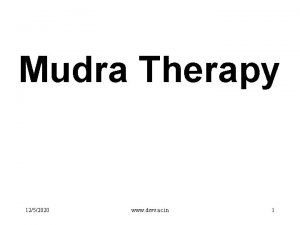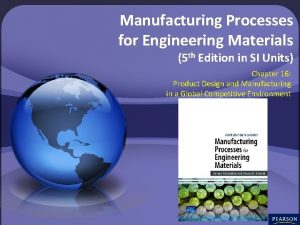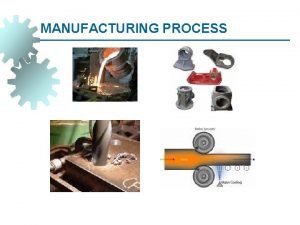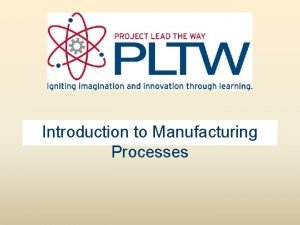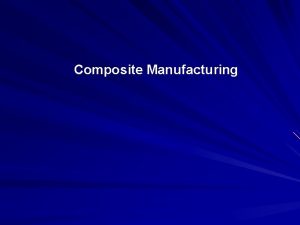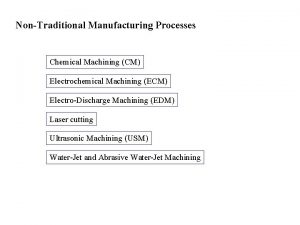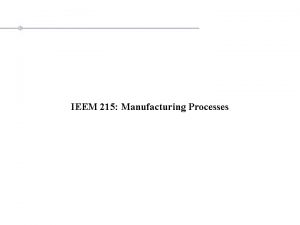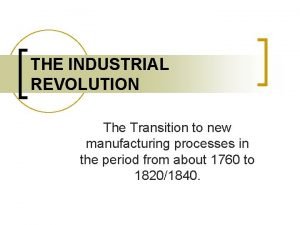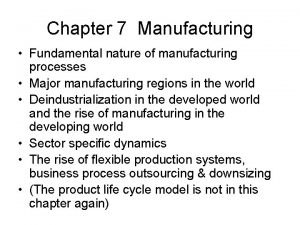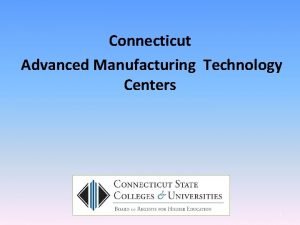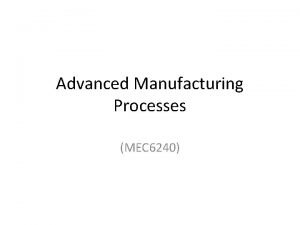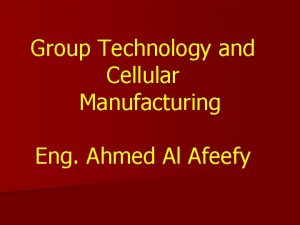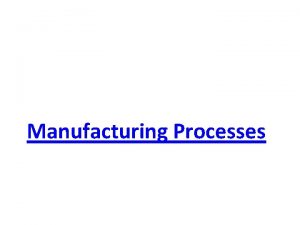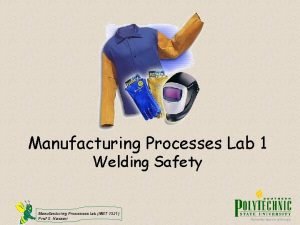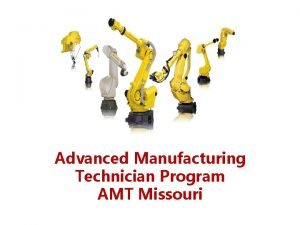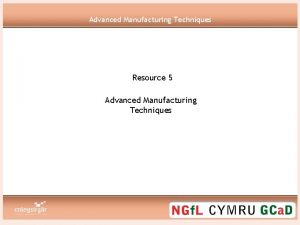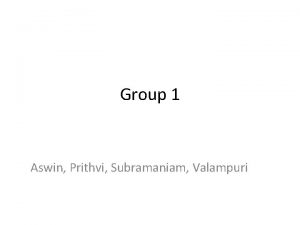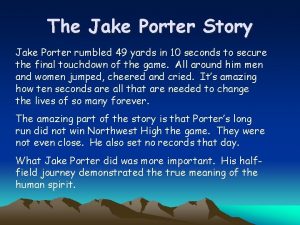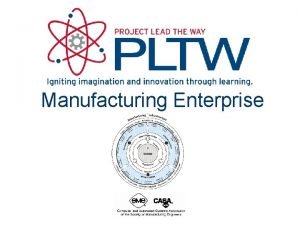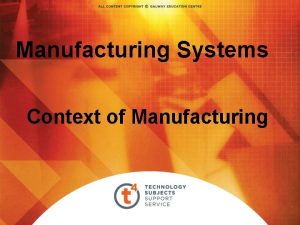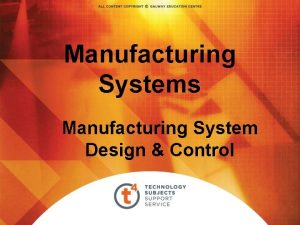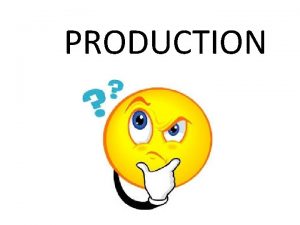Advanced Manufacturing Processes Group D Jake Stanko10 Prithvi



















- Slides: 19

Advanced Manufacturing Processes Group D: Jake Stanko(10), Prithvi Doddanavar(4), Kate Gilland(6), Kaushal Pathak(9)

Introduction ❖ Nanomaterials ➢ single unit of material sized between 1 and 1000 nanometers (10^-9 meters) ❖ Nanomanufacturing ➢ production of nanoscaled materials ➢ production of improved materials ➢ two basic approaches ■ top-down ■ bottom-up


Nanotubes ❖ What are nanotubes? ➢ Look like powder or black soot, developed from fullerene. ➢ Grown in a lab, strong have great thermal and electrical properties. ➢ Specifically carbon nanotubes have the ability to replace semiconductors.

Nanoscale Manufacturing Top-Down ❖ Large Building blocks ❖ Various manufacturing processes Bottom Up ❖ Small building blocks ❖ Similar to additive manufacturing tech.

The industry adopting nanomaterials and nanomanufacturing ❖ Alot of time and money is being spent on the development of nanomaterials because it has the potential to profoundly change our economy and improve our standard of living, in much the same way as information technology advances have revolutionized our lives and the economy over the past 2 decades. ❖ Scientists and engineers in almost all industries are developing nanotechnology to make their products stronger, lighter, more durable, more corrosion resistant and more economical. Many nanotechnology applications are quietly added to existing products to enhance performance. ❖ EXAMPLE: - Nanoparticles are used increasingly in catalysis to boost chemical reactions. This reduces the quantity of catalytic materials necessary to produce desired results, saving money and reducing pollutants.

Rapid Prototyping ❖ Rapid Prototyping is a collection of techniques used to quickly fabricate a scale model of a physical part or assembly using three-dimensional computer aided design. Importance Of Rapid Prototyping ❖ increase visualisation capability during the early phases of design by using rapid physical models ❖ detect design flaws before the manufacture of tooling ❖ rapidly create tooling to manufacture physical prototypes

Pictures of products made from RP

The different types of RP

Liquid Phase Stereolithography Fused Deposition Modeling http: //www. padtinc. com/blog/the-rp-resource/rapid-prototyping-technologyanimations Ballistic Particle Manufacturing

Powder Phase 3 D Printing Selective Laser Sintering

Solid Phase Laminated Object Manufacturing

Costs of Rapid Prototyping

Rapid Prototyping importance to metal casting ❖ quick, cost-effective, short-run production ❖ easily replicated patterns and matchplates ❖ selective laser sintering (SLS) for rapid metal prototypes ❖ stereolithography ❖ computer models → 3 D wax patterns → investment casting process

Nanomanufacturing involved in the medical industry ❖ 3 D printing is similar to FDM and both have the capability to contribute to the medical industry. ❖ The precision of 3 D printing will allow in the near future to produce and print organs. ❖ medical device manufacturing allows for custom production per the patient ❖ The girl born without a trachea

Printing of sand molds and cores for metal casting Producing sand molds and cast metal parts is relatively straightforward and suitable for automated methods that can reduce cycle time and labor. However, fabricating the patterns is often difficult, time-consuming and expensive. The biggest problems with this approach are the high cost and lengthy lead time. The solution to this problem is to use 3 D printing instead. Some of the benefits are as follows: 1. Pattern cost reduction of 50 to 70 percent 2. Lead-time reduction of 30 to 70 percent 3. Faster design revisions 4. Interchangeable gate and runner system



In conclusion http: //youtu. be/QD 2 Rdeo 8 vu. E This clip explains 3 D printing http: //www. me. psu. ac. th/~panya/461/RP_2550. pdf http: //www. phillipsmedisize. com/sites/default/files/whitepaper/Prototypin g%20 White%20 Paper. pdf
 Linga mudra images
Linga mudra images Manufacturing cost vs non manufacturing cost
Manufacturing cost vs non manufacturing cost Job costing definition
Job costing definition Non controllable cost
Non controllable cost Manufacturing cost vs non manufacturing cost
Manufacturing cost vs non manufacturing cost Additive manufacturing vs subtractive manufacturing
Additive manufacturing vs subtractive manufacturing Manufacturing process for engineering materials
Manufacturing process for engineering materials Classification of production process
Classification of production process Introduction to manufacturing processes
Introduction to manufacturing processes Advantages and disadvantages of pultrusion process
Advantages and disadvantages of pultrusion process Nontraditional manufacturing processes
Nontraditional manufacturing processes Similar
Similar The transition to new manufacturing processes
The transition to new manufacturing processes Fundamental manufacturing processes
Fundamental manufacturing processes Concurrent in os
Concurrent in os Ct advanced manufacturing
Ct advanced manufacturing Advanced manufacturing office
Advanced manufacturing office Advanced manufacturing process
Advanced manufacturing process Group technology and cellular manufacturing
Group technology and cellular manufacturing Group processes and dynamics
Group processes and dynamics
